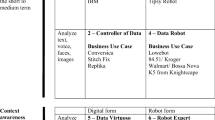Abstract
Throughout the history of the artificial intelligence movement, researchers have strived to create computers that could simulate general human intelligence. This paper argues that workers in artificial intelligence have failed to achieve this goal because they adopted the wrong model of human behavior and intelligence, namely a cognitive essentialist model with origins in the traditional philosophies of natural intelligence. An analysis of the word “intelligence” suggests that it originally referred to behavior-environment relations and not to inferred internal structures and processes. It is concluded that if workers in artificial intelligence are to succeed in their general goal, then they must design machines that are adaptive, that is, that can learn. Thus, artificial intelligence researchers must discard their essentialist model of natural intelligence and adopt a selectionist model instead. Such a strategic change should lead them to the science of behavior analysis.
Similar content being viewed by others
References
Berndt, T. J. (1992). Child development. Ft. Worth: Harcourt, Brace and Jovanovich.
Cherpas, C. (1992). Natural language processing, pragmatics, and verbal behavior. The Analysis of Verbal Behavior, 10, 135–147.
Conrad, M. (1992). Toward an artificial brain. Computer, 25, 79–80.
Crossman, E. K. (1985). The kiss and the promise: A review of Hubert L. Dreyfus’ What computers can’t co: The limits of artificial intelligence. Journal of The Experimental Analysis of Behavior, 44, 271–277.
Dreyfus, H. L. (1979). What computers can’t do: The limits of artificial intelligence. (Rev ed.) New York: Harper Colophon.
Futuyma, D. J. (1979). Evolutionary biology. Sunderland, MA: Sinauer.
Gardner, H. (1985). The mind’s new science: A history of the cognitive revolution. New York: Basic Books.
Malott, R. W., & Malott, M. K. (1970). Perception and stimulus generalization. In W, C, Stebbins (Ed.),Animal psychophysics: The desing and conduct of sensory experiments. New York: Appleton-Century-Crofts.
Palmer, D. C., & Donahoe, J. W. C. (1992). Essentialism and selectionism in cognitive science and behavior analysis. American Psychologist, 47, 1344–1358.
Sack, J. M. (1984). Cognitive science research. In T. O’Shea and M. Eisenstadt (Eds.),Artificial intelligence: Tools, techniques, and applications (pp. 155–177). New York: Harper & Row.
Searle, J. (1984). Minds, brain and science. Cambridge, MA: Harvard University Press.
Skinner, B. F. (1957). Verbal behavior. Englewood Cliffs, NJ: Prentice-Hall.
Skinner, B. F. (1974). About behaviorism. New York: Alfred Knopf.
Stephens, K. R., & Hutchison, W. R. (1992). Behavioral personal digital assistants: The seventh generation of computing. The Analysis of Verbal Behavior, 10, 149–156.
Todd, P. M. (1992). Two approaches to machine intelligence: The animat path to intelligent adaptive behavior. Computer, 25, 78–81.
Author information
Authors and Affiliations
Additional information
I am grateful to Dennis Kolodziejski for his helpful comments on an earlier version of this paper, which was presented in November, 1992 as part of the Faculty Forum series at Western New England College titled “Artificial and Natural Intelligence: Differences and Implications.”
Rights and permissions
About this article
Cite this article
Schlinger, H.D. Intelligence: Real or artificial?. Analysis Verbal Behav 10, 125–133 (1992). https://doi.org/10.1007/BF03392879
Published:
Issue Date:
DOI: https://doi.org/10.1007/BF03392879




